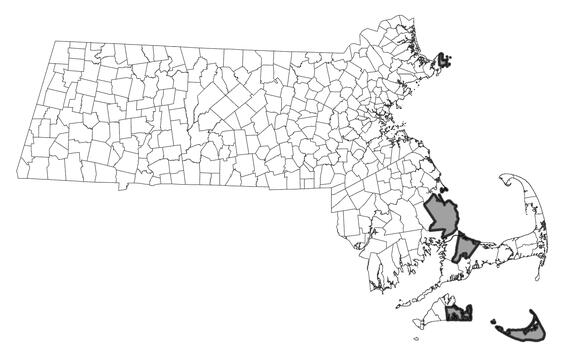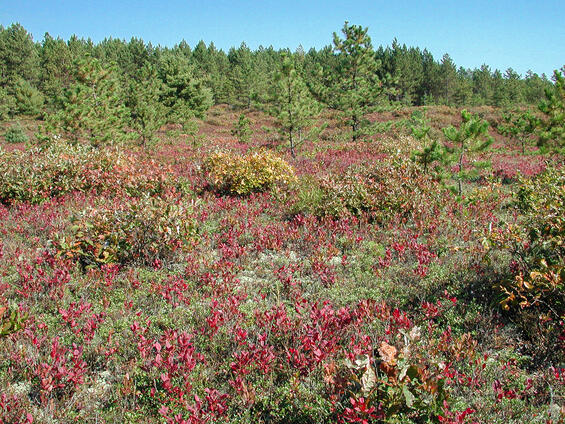- Scientific name: Chaetaglaea cerata
- Species of Greatest Conservation Need (MA State Wildlife Action Plan)
- Special Concern (MA Endangered Species Act)
Description

Waxed sallow moth, Chaetaglaea cerata.
The waxed sallow (Chaetaglaea cerata) is a noctuid moth with a wingspan of 46-50 mm (1.8-2.0 in; Forbes 1954). The forewing is grayish-brown, tinted with rose, with narrow yellow lines along the main veins and maroon, smoothly curved postmedial and antemedial lines, the latter margined with yellow proximally. A median line, similar in color but wider and more diffuse than the postmedial and antemedial lines, runs from the reniform (kidney-shaped) spot to the inner margin. The reniform and orbicular spots are narrowly outlined in yellow. The hind wing is grayish-brown, slightly tinted with rose, with a small, obscure discal spot. Wings of freshly emerged individuals have a waxy sheen. The head and thorax are concolorous with the forewing, and the abdomen is concolorous with the hind wing. The silky sallow (Chaetaglaea sericea) is similar; however, it has a reniform spot that is more elongate and a dark spot in the lower part of the reniform, which is absent in the waxed sallow. The wings of the silky sallow are more brown, lacking the rose tint of the waxed sallow, with dark brown (as opposed to maroon) postmedial and antemedial lines.
Life cycle and behavior

In Massachusetts, the waxed sallow moth flies in October, occasionally into early November. Eggs overwinter and hatch in early spring. Larvae feed on huckleberries (Gaylussacia spp.), lowbush blueberries (Vaccinium angustifolium and V. pallidum), and possibly other low-growing shrubs. Larvae pupate in late spring or early summer, diapausing through the summer and early fall.
Distribution and abundance
The waxed sallow moth is found from Maine south to West Virginia and west to Manitoba and Wisconsin; populations are disjunct and localized within this range. In Massachusetts this species is restricted to the coastal plain in the eastern part of the state.

Distribution in Massachusetts.
1999-2024
Based on records in the Natural Heritage Database.
Habitat
In Massachusetts, the waxed sallow moth inhabits sandplain pitch pine-scrub oak barrens and heathlands, occasionally also coastal forest with a heath understory, or maritime shrublands.
Healthy habitats are vital for supporting native wildlife and plants. Explore habitats and learn about conservation and restoration in Massachusetts.

Sandplain pitch pine-scrub oak barrens habitat with sparse trees and abundant huckleberry and lowbush blueberries, ideal habitat for the waxed sallow moth. Habitat managed by DCR and MassWildlife at Myles Standish State Forest.
Threats
The waxed sallow moth is threatened by habitat loss and fire suppression in its disturbance-dependent habitats, in particular sandplain pitch pine-scrub oak barrens and heathlands. Other potential threats include introduced generalist parasitoids, aerial insecticide spraying, non-target herbicide applications, and off-road vehicles. A warming climate may be detrimental to this species, as its range has a relatively narrow latitudinal extent, extending south only to West Virginia (and there only at elevation). Northward range expansion may be possible, though this has not yet been documented.
Conservation
Land protection and habitat management are the primary conservation needs of this species in Massachusetts. In particular, sandplain pitch pine-scrub oak barrens and heathlands should be conserved, restored, and managed to maintain habitat for this species and the entire suite of rare and threatened species dependent on such habitats.
Survey and monitoring
The distribution of the waxed sallow moth in Massachusetts is relatively well documented, though somewhat less than some species due to its autumn flight season. Known populations of this species should be surveyed to document persistence at least once every 25 years; every 10 years is more desirable when practicable.
Management
Management of sandplain pitch pine-scrub oak barrens and heathlands benefits a suite of rare and threatened species, and habitat condition should be monitored and management adapted as needed. For the waxed sallow moth, open barrens with a shrub layer including huckleberries (Gaylussacia spp.) and lowbush blueberries (Vaccinium angustifolium and V. pallidum) is of particular importance. The waxed sallow moth occasionally occurs in maritime shrublands, where the primary management need is control of invasive non-native plants.
Research needs
The natural history and conservation needs of the waxed sallow moth are relatively well known. However, the future effects of a warming climate on this species are unpredictable and should be documented.
References
Forbes, W.T.M. 1954. Lepidoptera of New York and Neighboring States. Part III. Memoir 329, Cornell University Agricultural Experiment Station, Ithaca, New York. 433 pp.
Contact
| Date published: | March 24, 2025 |
|---|